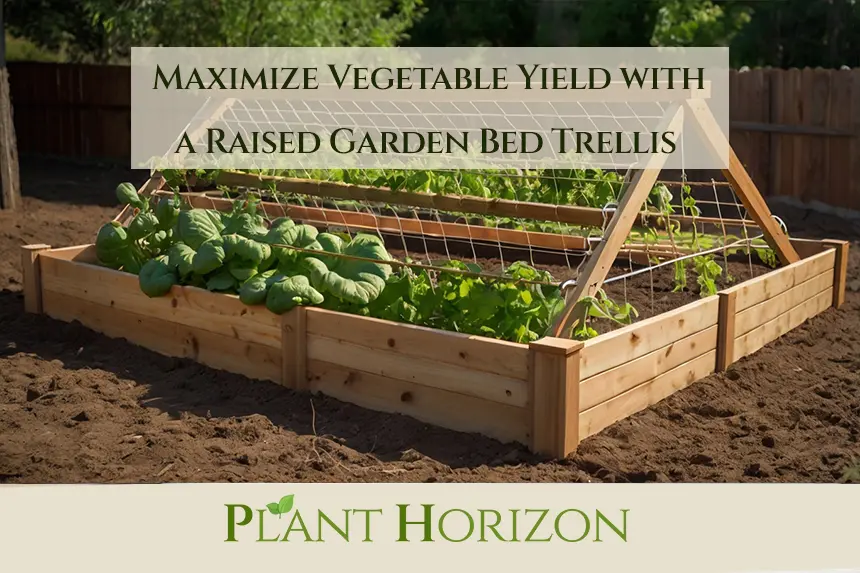Looking to optimize your vegetable garden for maximum yield while saving space? Using a raised garden bed trellis is one of the smartest and most efficient methods to grow fresh, healthy produce in your backyard. This strategy not only maximizes your garden’s output but also improves accessibility, minimizes pests, and elevates your gardening game to the next level. Whether you’re an experienced gardener or just starting out, building a raised garden bed with a trellis could be the key to achieving a lush, productive garden.
What Is a Raised Garden Bed Trellis?
A raised garden bed trellis combines the benefits of elevated gardening with vertical growing. A raised garden bed elevates your gardening space above ground level, offering better soil control, enhanced drainage, and easier maintenance. When you add a trellis, you introduce vertical gardening to the equation, which allows climbing plants like tomatoes, cucumbers, peas, and beans to grow upward rather than spread across the soil.
This combination saves space, boosts yields, and creates a visually stunning garden layout. For those working with limited gardening areas, such as urban or small backyard spaces, a raised bed with a trellis is a game changer.
Benefits of Using a Raised Garden Bed Trellis
Maximized Space Utilization
By growing plants vertically, you’ll significantly reduce the horizontal footprint of your vegetables. This is particularly beneficial if you’re gardening in a compact space. A trellis allows plants to climb instead of sprawling across horizontal surfaces, freeing up room for more crops.
Improved Air Circulation
When plants grow upward, airflow increases around the foliage, which helps to prevent fungal diseases. This improved circulation also keeps plant leaves drier, reducing the risk of issues like powdery mildew.
Enhanced Access and Harvesting
With vegetables growing on a trellis, you don’t have to bend or crouch as much when watering, pruning, or harvesting. The raised elevation further eases the gardening process by putting your plants at an accessible height.
Healthier Plants and Bigger Yields
By training plants to grow vertically, you’ll expose them to more sunlight, which promotes healthier development and higher yields. Additionally, keeping crops off the ground minimizes exposure to pests such as slugs and snails, resulting in more robust produce.
How to Build a Raised Garden Bed With a Trellis

Step 1: Choose the Right Location
Select a sunny spot in your garden. Most vegetables thrive with at least 6–8 hours of direct sunlight daily. Observe your space throughout the day to identify areas that receive consistent light exposure.
Step 2: Select the Materials
For the bed, use wood materials resistant to rot, such as cedar or redwood. Alternatively, galvanized metal is a great, durable option. For the trellis, you can opt for materials like metal mesh, wire fencing, nylon netting, or wooden lattice. Make sure all materials are sturdy and can support the weight of climbing plants as they grow.
Step 3: Build the Raised Garden Bed
Construct a rectangular or square frame for the raised bed. Secure the corners tightly and ensure the structure is level. Fill the bed with rich, organic soil blended with compost for added nutrients. For extra tips on creating nutrient-rich soil blends, check out the informational guides at Plant Horizon.
Step 4: Install the Trellis
Attach the trellis to the raised bed’s back edge using screws or brackets. Ensure the trellis is securely fixed, as it will need to support the full weight of climbing plants. Alternatively, you can install freestanding trellises directly behind the raised bed for added flexibility.
Step 5: Plant Vegetables and Train Them
Select climbing or vining crops that thrive on trellises, such as peas, cucumbers, tomatoes, or pole beans. Plant seeds or seedlings along the base of the trellis and gently guide them to climb as they grow. Use garden ties or clips to secure vines early to encourage upward growth.
Best Vegetables to Grow on a Raised Garden Bed Trellis
- Tomatoes: Indeterminate varieties are perfect for vertical growth because they produce fruit continuously and can grow tall.
- Cucumbers: These fast-growing climbers thrive on trellises and produce high yields.
- Peas: Both garden peas and snap peas quickly scale upward with proper support.
- Pole Beans: Unlike bush beans, pole beans require vertical support and yield prolifically when grown on a trellis.
- Squash: Small varieties like zucchinis can climb if trained on sturdy supports.
Maintenance Tips for Raised Bed Trellising
1. Monitor Plant Growth
As your crops grow, inspect them regularly to ensure they are climbing the trellis properly. Adjust ties or clips as needed to keep vines secured and growing in the right direction.
2. Prune as Necessary
Remove damaged leaves and overgrowth to promote air circulation and maintain the plant’s focus on producing fruit.
3. Water Effectively
Raised beds tend to dry out faster than in-ground gardens, so ensure consistent watering. Soaker hoses or drip irrigation systems work well to maintain soil moisture without soaking the foliage.
4. Regularly Check for Pests
Although trellising reduces pest problems, it’s still important to watch for signs of infestation. Check leaves and stems for common garden pests such as aphids or caterpillars.
Potential Challenges and How to Overcome Them
Weight and Stability
Climbing plants can become heavy as they mature, potentially causing weaker trellises to wobble or fall. To avoid this, use sturdy materials and secure the structure firmly to the bed or ground.
Soil Requirements
Raised beds require nutrient-dense, well-draining soil. Regularly amend the soil with compost or organic fertilizers to replenish nutrients, particularly after heavy growing seasons.
The Bottom Line
A raised garden bed with a trellis is a brilliant way to maximize vegetable yield while enhancing your gardening experience. From increased air circulation to higher accessibility, the combination of raised beds and vertical gardening offers numerous advantages for gardeners of any skill level. By following the steps outlined above, you’ll create an efficient and beautiful garden setup that not only saves space but also boosts productivity. Ready to up your gardening game? Start your raised bed project today for a healthier, more rewarding harvest!











